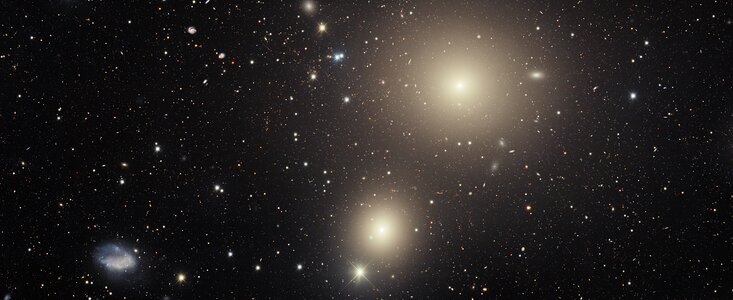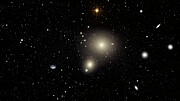Plunging into the Furnace
The Víctor M. Blanco Telescope in Chile captures a doomed galaxy falling into the heart of the Fornax Cluster
23 September 2021
The denizens of the Fornax galaxy cluster populate this image from the Víctor M. Blanco 4-meter Telescope, located in Chile at Cerro Tololo Inter-American Observatory (CTIO), a Program of NSF NOIRLab. The irregular galaxy lurking in the bottom left corner of this Dark Energy Survey image is NGC 1427A, and its headlong plunge into the heart of the Fornax Cluster over millions of years will eventually result in the galaxy’s disruption.
The Fornax Cluster — which, as the name suggests, lies primarily in the constellation Fornax (the Furnace) — is a relatively nearby galaxy cluster, only about 60 million light-years from Earth. This means that it looms large in the night sky, stretching across an area more than 100 times larger than the full Moon. With over 600 member galaxies, the Fornax Cluster is the second “richest” (most populous) galaxy cluster within 100 million light-years of our galaxy (after the much larger Virgo Cluster).
Two elliptical galaxies dominate the center of this image — visible as the two large patches of diffuse light with bright cores. Such galaxies usually contain much older stars than the more picturesque spiral galaxies, and they tend to be found in galaxy clusters such as the Fornax Cluster. These elliptical galaxies — which are named NGC 1399 and NGC 1404 — are among the brightest members of the Fornax Cluster and are inexorably being drawn together by the force of gravity. This interaction is stripping gas from NGC 1404, the lower elliptical galaxy in this image.
In the bottom left corner of the image appears the irregular galaxy NGC 1427A. This ragged patch of light is a small, irregular collection of stars similar to the Large Magellanic Cloud. Similarly to NGC 1404, NGC 1427A is plunging toward the heart of the cluster at roughly 2.2 million kilometers (or 1.3 million miles) per hour. This headlong rush to destruction will eventually result in the galaxy being disrupted — pulled apart by gravitational interactions with other galaxies.
As with most astronomical observations, this image shows not only the intended target but also a menagerie of objects both close to home and at tremendous distances. The image is dotted with interloping objects from within our own Milky Way — bright stars with diffraction spikes [1]. At the other extreme, distant galaxies provide a colorful backdrop to this image: some are recognizable as spiral galaxies, while others are mere smudges. Despite appearing tiny in this image, each of the distant galaxies contains billions of stars.
This image was captured by the 570-megapixel Dark Energy Camera (DECam), one of the highest-performance, wide-field imagers in the world, as part of the Dark Energy Survey. Funded by the US Department of Energy (DOE) and built and tested at DOE’s Fermilab, DECam was operated by DOE and the National Science Foundation (NSF) between 2013 and 2019. Among its many accomplishments, DECam observations have helped astronomers discover nearly 300 previously unknown dwarf galaxies in the Fornax Cluster.
At present DECam is used for programs covering a huge range of science. Like other survey instruments, DECam captures images of large swaths of the night sky, allowing astronomers to understand structures in the Universe at large scales. Telescope surveys also help identify intriguing astronomical objects worthy of follow-up observation; the most powerful telescopes can only study a minute portion of the night sky at any given time, so astronomers often use surveys to find objects that are interesting enough to observe in detail.
The analysis of data from the Dark Energy Survey is supported by DOE and the NSF, and the DECam science archive is curated by the Community Science and Data Center (CSDC) at NSF’s NOIRLab.
Notes
[1] Diffraction spikes are formed by light interacting with the inner structure of a telescope, and they can be used to tell something about the telescope that captured an image. Most professional telescopes have a secondary mirror suspended above the main mirror by several thin vanes. These vanes — which together form a structure known as a “spider” — interact with starlight to produce diffraction spikes, with the number of vanes determining the pattern of the resulting spikes.
More information
NSF NOIRLab (National Optical-Infrared Astronomy Research Laboratory), the US center for ground-based optical-infrared astronomy, operates the international Gemini Observatory (a facility of NSF, NRC–Canada, ANID–Chile, MCTIC–Brazil, MINCyT–Argentina, and KASI–Republic of Korea), Kitt Peak National Observatory (KPNO), Cerro Tololo Inter-American Observatory (CTIO), the Community Science and Data Center (CSDC), and Vera C. Rubin Observatory (in cooperation with DOE’s SLAC National Accelerator Laboratory). It is managed by the Association of Universities for Research in Astronomy (AURA) under a cooperative agreement with NSF and is headquartered in Tucson, Arizona. The astronomical community is honored to have the opportunity to conduct astronomical research on Iolkam Du’ag (Kitt Peak) in Arizona, on Maunakea in Hawai‘i, and on Cerro Tololo and Cerro Pachón in Chile. We recognize and acknowledge the very significant cultural role and reverence that these sites have to the Tohono O'odham Nation, to the Native Hawaiian community, and to the local communities in Chile, respectively.
This work is supported in part by the US Department of Energy Office of Science. The Dark Energy Survey is a collaboration of more than 400 scientists from 26 institutions in seven countries. Funding for the DES Projects has been provided by the US Department of Energy Office of Science, US National Science Foundation, Ministry of Science and Education of Spain, Science and Technology Facilities Council of the United Kingdom, Higher Education Funding Council for England, ETH Zurich for Switzerland, National Center for Supercomputing Applications at the University of Illinois at Urbana-Champaign, Kavli Institute of Cosmological Physics at the University of Chicago, Center for Cosmology and AstroParticle Physics at Ohio State University, Mitchell Institute for Fundamental Physics and Astronomy at Texas A&M University, Financiadora de Estudos e Projetos, Fundação Carlos Chagas Filho de Amparo à Pesquisa do Estado do Rio de Janeiro, Conselho Nacional de Desenvolvimento Científico e Tecnológico and Ministério da Ciência e Tecnologia, Deutsche Forschungsgemeinschaft, and the collaborating institutions in the Dark Energy Survey.
NCSA at the University of Illinois at Urbana-Champaign provides supercomputing and advanced digital resources for the nation’s science enterprise. At NCSA, University of Illinois faculty, staff, students, and collaborators from around the globe use advanced digital resources to address research grand challenges for the benefit of science and society. NCSA has been advancing one-third of the Fortune 50® for more than 30 years by bringing industry, researchers, and students together to solve grand challenges at rapid speed and scale.
Fermilab is America’s premier national laboratory for particle physics and accelerator research. A US Department of Energy Office of Science laboratory, Fermilab is located near Chicago, Illinois, and operated under contract by the Fermi Research Alliance LLC, a joint partnership between the University of Chicago and the Universities Research Association, Inc.
The DOE Office of Science is the single largest supporter of basic research in the physical sciences in the United States and is working to address some of the most pressing challenges of our time.
Links
Contacts
Vanessa Thomas
Public Information Officer
NSF NOIRLab
Tel: +1 520 318 8132
Email: vanessa.thomas@noirlab.edu
About the Release
| Release No.: | noirlab2126 |
| Name: | Fornax Cluster |
| Facility: | Víctor M. Blanco 4-meter Telescope |
| Instruments: | DECam |







